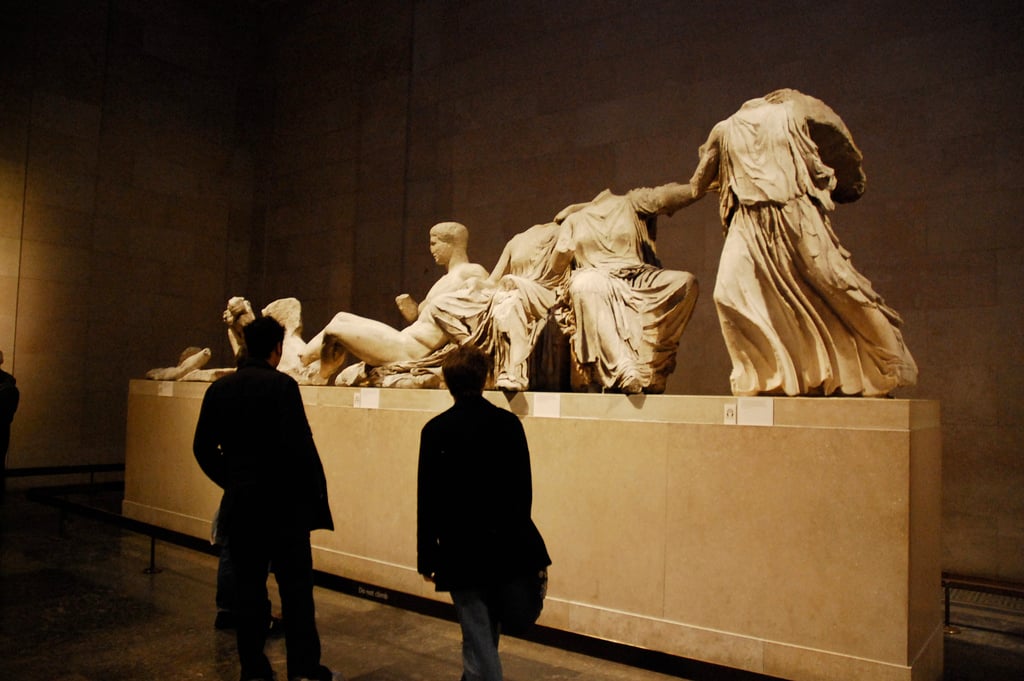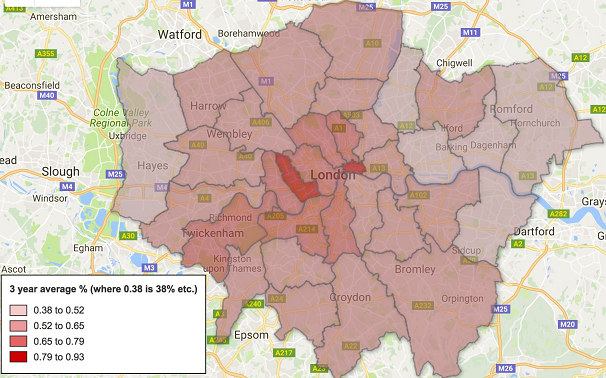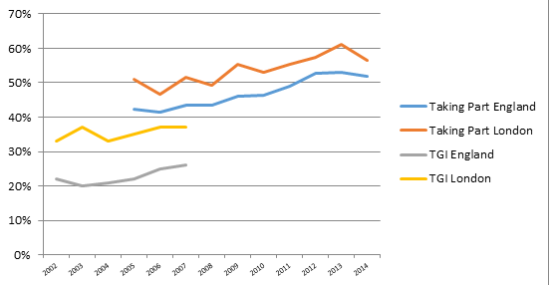
Photo: Edmund Nigel Gall via Visualhunt / CC BY-SA
Looking at Londoners
Visitor numbers may have grown, but the diversity of museum-goers in London has hardly changed over the past ten years. James Doeser and colleagues suggest what new research is needed if London’s museums are to understand how to attract new audiences.
Earlier this year Creative Works London and I gathered together a room of experts to fashion an audience research agenda for London museums. There were a number of surprising themes. Sure, the who, when and why questions about visits and visitors persist, but much of the talk was about how museums are viewed by their board, staff, friends and the wider public.
The proportion of visitors in under-represented groups hasn’t really changed in spite of all the encouragement from government, funders and within the museum sector
Another strong theme was how museums can get themselves (staff, board, volunteers) better aligned on matters of mission and purpose. The message was a challenging one for us researchers: “It’s all well and good giving us the facts, but we need help to make them stick and to provoke change in our institutions.”
Changes and trends
We began with two historical questions: How have visitors to London’s museums changed over the past 15 years? And how have the museum-going habits of Londoners changed?
We recognise that London itself is not a homogenous place when it comes to museums and museum-going, as Orian Brook recently demonstrated in AP and as data from the Active People survey shows.
 Average relative levels of museum and gallery going by London borough 2008–10
Average relative levels of museum and gallery going by London borough 2008–10
The Taking Part survey has collected data on museum-going since 2005 and has highlighted a few relevant and persistent trends over the last decade:
- The number of people saying they visit museums at least once a year has gone up.
- Londoners tend to be more likely than the English average to visit museums.
- Ethnic minorities, disabled people and those from lower socio-economic groups who live in London are less likely to visit museums than Londoners in general.
The Target Group Index (TGI) survey was the preferred data source before Taking Part got going. It used different methodologies so we focused on trends rather than the differences between the two surveys, but by plotting the two data sets together we arrived at a long-term picture of museum-going in England.
 The percentage of adults who say they have visited a museum or gallery at least once in the past 12 months
The percentage of adults who say they have visited a museum or gallery at least once in the past 12 months
Over this period there have been unprecedented levels of funding and public policy has been directed at increasing museum attendance. Such interventions have included:
- The introduction of free admission to national museums in 2001.
- The revitalisation of major non-national museums through Renaissance in the Regions between 2002 and 2011 and after that with Arts Council England funding.
- The government’s energetic targets and performance management regime from the early 2000s.
- A move from the Heritage Lottery Fund to place greater emphasis on learning and participation.
Success or failure
Audience research has been crucial throughout this period to grasp the baseline levels of museum attendance, to understand what factors might act as barriers and motivations for people to attend museums, and to measure the relative success or failure of policies and programmes to increase attendance.
In general, we find that policy, research and extra resources have done much to increase attendance overall and revolutionise the galleries, exhibitions and additional programmes that many museums offer. However, it has not really resulted in a concomitant change in the profile of the museum-going public, neither among Londoners nor the population as a whole. A deeper dive into the Taking Part data shows that visitors remain predominantly white, middle-class and able-bodied, at least more so than the population as a whole.
Inconsistent data
Who are the visitors to London’s museums? This is actually a much harder nut to crack. Museums, especially ones without an entry ticket or box office system, do not consistently collect data like other parts of the arts sector. So there hasn’t been a consistent methodology, and many museums haven’t been all that motivated to collect demographic data about their visitors.
The Taking Part survey, although helping government assess the impact of its policies, does not actually distinguish between subsidised and non-subsidised museums. So respondents may well give the same answer whether they have been to the Tate Modern or Madame Tussauds or if they visited a museum when away on holiday.
We pieced together what we could and were given a huge boost by some anonymised data from strategic research consultancy Morris Hargreaves McIntyre (MHM), which had collected data from many of the big national museums in London. The British Museum and the South Kensington institutions so dominate the London museum landscape it’s vital that their data is in the mix.
MHM found a huge variation between the major national museums in the capital, and not many discernable trends. Proportions of visitors with disabilities, from ethnic minorities or lower-socio-economic groups wobble up and down a few percentage points but there isn’t a particular trend up or down.
Visitor numbers at the major national museums in the capital have increased substantially in the last ten years, but the proportion of visitors in under-represented groups hasn’t really changed in spite of all the encouragement from government, funders and within the museum sector.
A research agenda
We identified the main themes where there were unanswered research questions, and where we felt museums should pay greater attention. These were the research process, socio-demographic factors of museum audiences, decision-making about museum-going (both in terms of human dynamics and also in terms of the ‘offer’) and visitor behaviour.
This yielded six priority research questions to help museums achieve current objectives:
- How does somebody arrive at the decision to visit a museum? This is about understanding the dynamics of individual and family decision-making, about the exhibit, the museum, its location and how it competes with other leisure options.
- Once at the museum, how do people decide what journey to take through the building? It wasn’t clear how (or whether) museums could or should be prescriptive about how people move through the space.
- How have museums successfully helped visitors to overcome the barriers they face? Audience research tends to focus on identifying the barriers that people face when it comes to museum-going and far less information is available on what specific interventions have worked to overcome such barriers.
- Why do people stop visiting, cancel their memberships or stop donating? For obvious reasons it can be difficult to capture the necessary information to address this research question as ex-customers can be hard to recruit to a focus group.
- To what extent is a museum’s mission understood and interpreted differently by different stakeholders and how does that affect audiences and visitors? This question can be addressed through some fairly standard stakeholder research (surveys and interviews). But sometimes an organisation’s mission can be very opaque (or kept intentionally behind the scenes) and it’s therefore quite a challenge to detect the way it affects those outside the core of an organisation.
- How can audience research be factored in to museum strategy and delivery? This requires an understanding of the processes and motivations of key decision-makers in museum policy and strategy development. It’s likely that some exemplary cases can be identified and lessons learned, but so much of this comes down to individual leadership behaviours and there may not be a replicable model to follow.
London factors
None of these are especially London-centric questions and the numbers from national surveys and specific institutions may in fact mask any London-specific stories. It would be fascinating to know whether there are London-specific factors that influence the behaviour of Londoners when it comes to museums.
Is there something about the type of people who live here, the schools system, the transport infrastructure, the household composition or the multicultural nature of the place that gives Londoners a distinct attitude and behavioural outlook to people outside the capital?
Or is it that there is a greater supply of museums in London than elsewhere? This is something we hope to address in future research.
James Doeser is a cultural researcher. Additional input from Maurice Davies, Mariza Dima and Christian Heath from Creative Works London.
jamesdoeser.com
www.creativeworkslondon.org.uk
Join the Discussion
You must be logged in to post a comment.